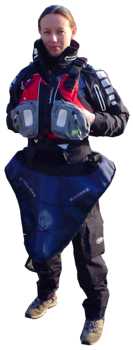
In his classic book Living Canoeing (A&C Black, 1969) Alan Byde said anybody going kayaking "begins ... by getting wet ... Some have been known to say 'I don't intend to get wet', and really they believe it. My kind of canoeing soon disposes of fancy notions like that". Ours too.
Kayaking clothing should keep you comfortable while you are in your kayak and active, even if you are soaking wet in a strong wind. It should also protect you from cold shock if you suddenly go for an accidental swim, and enable you to stay fully functional despite a 15 minute immersion during a rescue. See Cold Shock, Swim Failure & Hypothermia.
Kayak instructors often advise that kayakers should "dress for immersion". They don't mean you to wear clothing which would keep you comfortably warm if you spent several hours floating in cool water. Water can suck heat out of your body 25 times faster than air at the same temperature, and clothing able to resist that would be too hot and bulky for an active sport.
Summer or winter, essential clothing consists of a sprayskirt, a waterproof jacket, and a PFD. The average cool-climate kayaker will also want a wetsuit, wetsuit boots, and a few synthetic base-layer and fleece tops. By mixing them to suit the activity and the weather, you have cost-effective clothing which will keep you comfortable and safe all year round. Wetsuits are a bit sweaty and we discuss some alternatives below.
In a competitive marketplace, manufacturers often add features such as pockets, pouches, hoods and hydration systems. Simple designs are fine and have less tendency to trap water when you are rolling up from a capsize.
Base-layer and fleece garments can be washed in a machine. Other kayak clothing and equipment is just rinsed in fresh water and hung up to dry. See Storing Kayak Clothing, Etc.
Sprayskirt
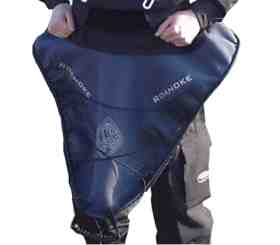 By sealing the gap between kayak and kayaker, a sprayskirt makes a kayak very seaworthy. It must stay in place even if hit by a big wave.
By sealing the gap between kayak and kayaker, a sprayskirt makes a kayak very seaworthy. It must stay in place even if hit by a big wave.
Most sea kayaks have a rim around the edge of the cockpit (the coaming) which creates a U-shaped channel as in the picture below.
Most sprayskirts consist of a vertical tube of fabric for your waist, joined to a horizontal deck which is the same shape as your cockpit. The horizontal part has a stretchy ring to attach it firmly to the coaming. This may be a thick elastic cord sewn to the edge or a solid rubber rand, glued on.
There is also a grab loop at the front so you can get it off the coaming when you want to. Make sure it's on the outside when you put on the sprayskirt. If you put it on with the release strap inside the kayak, you may find you are trapped after capsizing.
The waist tube may have straps going over the shoulders to stop the deck sagging and collecting a pool of water just behind you, where it will probably trickle down your back. If too short, shoulder straps may cause your sprayskirt to pop off when you roll.
Floppy sprayskirt
Once upon a time, all sprayskirts were made of nylon fabric coated with a thin layer of neoprene or PVC (vinyl). They didn't stay on very well, and collected a large puddle of water.
They are still useful for kayaking on calm seas in hot weather. A one-size-fits-all floppy sprayskirt with adjustable elastic can be a useful safety item for a group.
High-tech sprayskirt
For our sort of sea kayaking you need a top-quality modern sprayskirt made of a high-performance fabric so that it will stay solidly in place and waterproof whatever the sea does.
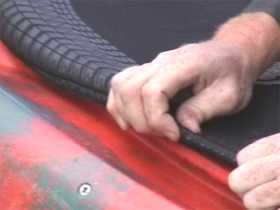 |
The parts which grip the cockpit coaming or may get damaged in a deep-water rescue are usually painted with a layer of sticky black latex rubber.
If you want a bombproof sprayskirt you probably want it made of double-lined 4 mm wetsuit material with waterproof seams. One reason it stays on is that it stretches but not very much. If you struggle to get your sprayskirt onto your cockpit coaming, try dunking it in the water a few times until it is soaked inside and out. Wetsuit material is stretchier when wet. |
Waterproof kayaking jacket
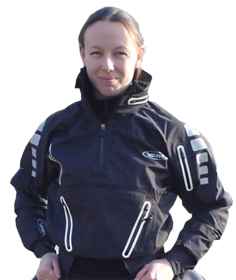 |
After the kayak, the paddle and the sprayskirt which protects a kayaker up to the chest, a good waterproof jacket is the most important item of kayaking equipment. They are sometimes called paddle jackets, anoraks, anoraqs, tops or cags (short for cagoule).
If the weather is nice you may leave it rolled up and pushed behind your seat, but there's a good chance you will want it at some point.
A jacket must be made of waterproof material but not necessarily the most expensive available. See Breathable & Non Breathable Fabrics. The seams of the jacket must be waterproof, which in practice means they must be finished internally with a layer of tape.
A jacket is unlikely to have the right shape and features unless it was specifically designed for kayaking. |
Design
A paddling jacket with long sleeves will protect you from cold and sunburn.
If you kayak in a cool climate you need skin-tight seals at the neck and wrists to keep water out. If your wrists and forearms get too cold, for example during a deep-water rescue, your hands will not function. See Cold Shock, Swim Failure & Hypothermia. Wrist seals provide good protection against this. Cheaper jackets have seals of thermal stretch material. Probably a little water will get past them during a kayak session but that is not a problem. More expensive jackets have seals made of thin latex rubber which prevent any water entering but which need some care and will eventually need replacing. For latex seal maintenance, click here. If a jacket has really effective seals at neck, wrist and waist it's a drytop.
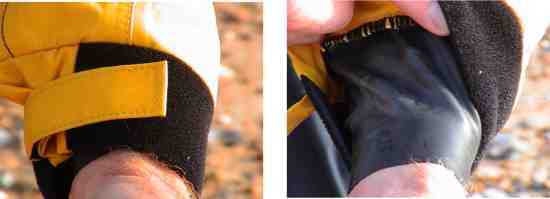
Kayaking jackets are short so that you don't have a rolled-up sausage of loose fabric sitting on your sprayskirt.
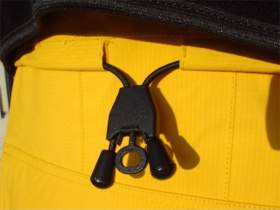 They have something at the waist (a draw-cord, a belt or an elasticated hem) to keep water from flooding up into the jacket in waves or in a capsize. Some have a double waist so that one part of it goes inside your sprayskirt and the other part goes over the top.
They have something at the waist (a draw-cord, a belt or an elasticated hem) to keep water from flooding up into the jacket in waves or in a capsize. Some have a double waist so that one part of it goes inside your sprayskirt and the other part goes over the top.
Kayaking jackets don't generally have any thermal insulation but are worn over a wetsuit and base layer shirt and / or a synthetic fleece pullover. They seldom have a zipper, other than a small one at the neck. The underarm area is cut generously, for unrestricted arm movement.
If you are out in cold, wet, windy conditions you lose a lot of heat from your head because it is very exposed and the body doesn't have the option of reducing blood supply to save heat. This is a good argument for having either a hood on your jacket or a hat and/or a helmet. Most of the Kayarchy contributors like jackets without a hood but with a storm collar, which is an outer collar that acts almost like a scarf for your neck. Jackets with a hood are more expensive. Because a hood covers your ears, it can be hard to tell if a gust of wind or a big wave is coming; and if you capsize the hood can fill with water and make it less easy to roll back up.
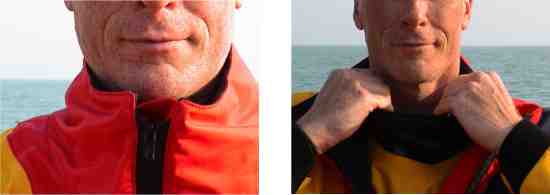
Tuiliq
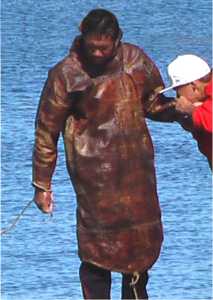 When it comes to waterproof kayaking jackets, Greenlandic kayakers have always favored the tuiliq or tuilik. This is a long garment with a hood which fits closely around the face (but is drawn back at the sides so as not to impair vision), cuffs which can be tied closely around the wrist, and a waist which fits closely round the cockpit coaming so there is no need for a separate sprayskirt.
When it comes to waterproof kayaking jackets, Greenlandic kayakers have always favored the tuiliq or tuilik. This is a long garment with a hood which fits closely around the face (but is drawn back at the sides so as not to impair vision), cuffs which can be tied closely around the wrist, and a waist which fits closely round the cockpit coaming so there is no need for a separate sprayskirt.
In Greenland, especially during kayaking competitions, you will often see a tuiliq made of seal skin. For these you may still need a friend with strong teeth to tie the cord that keeps the cuffs a close fit around your wrists.
Some small manufacturers now make them in materials such as thermal stretch or Gore-Tex. The seams are glued, taped or welded to make them completely watertight. Ideally, a tuiliq is designed and made so you can wear the hood down except in very bad conditions or for rolling practice. The thinner the material of which the hood is made, the more likely it is that you will be able to breathe, swallow and turn your head with it rolled down round your neck.
A tuilik is a baggy fit except at the cuffs and the neck/face opening. This means that your arm movements are unrestricted. For really cold conditions a tuilik may be cut so baggy that it fits over the top of your PFD. A tuiliq must perform effectively as a sprayskirt. It must not pop off if a wave breaks on you. See Sprayskirt. It must also have enough slack to let you do layback rolls which means the front is likely to hang down to your knees when you are walking around.
Combined with an authentic Greenland kayak, a tuiliq opens the way to some additional techniques such as a different way to scull for support.
If you wear a tuilik over fleece garments you will get less sweaty than if you are wearing an ordinary paddle jacket. But the usual rule applies - dress for immersion. If you kayak on cool water you should consider wearing a wetsuit or drysuit under your tuiliq. If you go for an accidental swim, a tuiliq on its own will not prevent cold water reaching almost every part of your body at the same moment. See Cold Shock, Swim Failure & Hypothermia.
Personal buoyancy
Most sea kayakers wear personal buoyancy all the time they are on the water. In Canada, sea kayakers are required to have a PFD or lifejacket. Open-water kayakers in the USA are generally required to carry personal buoyancy of a design approved by the USCG and in some states and in some circumstances it is compulsory to wear it, not just carry it. For example with effect from November 2009 legislation in in New York State says "no owner or operator of a pleasure vessel less than twenty-one feet, including rowboats, canoes, and kayaks, shall permit its operation between November first and May first, unless each person on board such vessel is wearing a securely fastened United States Coast Guard approved wearable personal flotation device of an appropriate size when such vessel is underway."
PFD
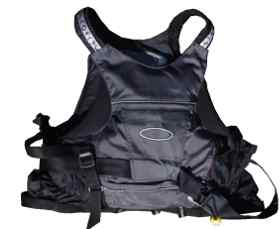 Sea kayakers usually prefer a PFD designed for kayaking.
Sea kayakers usually prefer a PFD designed for kayaking.
This one has a small slab of closed-cell foam on the chest, another on the back, adjustable straps at the waist and sides, and shoulder straps. Some have a front zipper. An adult kayaker probably needs 50 newtons of permanent foam flotation or 75 newtons for a large adult. It's not much - 50 newtons will only just float a weight of 12 lbs.
PFDs help keep you warm, compress your waterproof jacket so it cannot fill with water if you are upside down, reduce the likelihood of cold shock and are useful body armor if you collide with somebody while surfing. They help you float but they don't help you swim. The drag from a 50 newton PFD makes swimming very slow indeed.
They usually have a small pocket on the chest which will hold a few small objects safely. A PFD pocket is a very good place to keep your VHF radio, with the reservation that large pockets may fill with water if you capsize and make it less easy to roll. The rescue features of a whitewater PFD are seldom any use to a sea kayaker and an aluminum carabiner will quickly corrode solid at sea.
Lifejacket
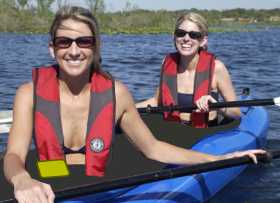 Lifejackets are less effective than PFDs as body armor and thermal insulation, but they are better in rough water because they make you float higher. They may be better all round if you kayak mainly in hot weather or there is a risk you may spend a long time floating in the sea awaiting rescue.
Lifejackets are less effective than PFDs as body armor and thermal insulation, but they are better in rough water because they make you float higher. They may be better all round if you kayak mainly in hot weather or there is a risk you may spend a long time floating in the sea awaiting rescue.
Be careful what you buy, because most modern lifejackets are expensive junk with a very short shelf life. They consist of a waistcoat made of a cheap nylon fabric, containing an inflatable bladder that's usually made of urethane-coated nylon. In my experience, the seams of the bladder soon start to leak where the deflated bladder is folded to fit inside the waistcoat, and the urethane also soon starts to peel off the nylon. If you want a supple, comfortable lifejacket that lasts ten or fifteen years, in my personal opinion you need one that's hand-made from the finest neoprene-coated nylon.
Waistcoat-style lifejackets like this one (photo courtesy of US Coast Guard) are very compact and almost invisible in normal use. In emergency they can be inflated to give 150 newtons of buoyancy, mainly on the chest but with some round the back of the neck to keep an unconscious person floating on his back with his face out of the water.
150 newtons will float a weight of nearly 40 lbs and in some self-rescue techniques this advantage is used to lift a flooded kayak a little further out of the water.
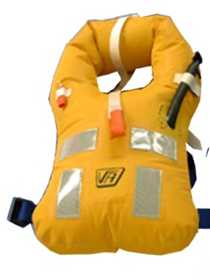 The other style of lifejacket is the Mae West type which has about 50 newtons of permanent foam buoyancy, mainly on the chest. This one is built to last, using military specification neoprene-coated nylon. It looks bulky because it's inflated to 150 newtons. It has a whistle on the left, an oral inflation tube on the right, and the short orange strap in the middle is a lifting becket which can be used to lift a casualty out of the water. The light-colored patches are reflective tape.
The other style of lifejacket is the Mae West type which has about 50 newtons of permanent foam buoyancy, mainly on the chest. This one is built to last, using military specification neoprene-coated nylon. It looks bulky because it's inflated to 150 newtons. It has a whistle on the left, an oral inflation tube on the right, and the short orange strap in the middle is a lifting becket which can be used to lift a casualty out of the water. The light-colored patches are reflective tape.
Many lifejackets can be inflated by squeezing a lever to pierce a small cylinder of carbon dioxide. This isn't necessary for sea kayaking. The inflation mechanism will eventually corrode. If you accidentally trigger it after inflating the lifejacket by mouth, for example during a rescue exercise, the lifejacket may burst.
Whistle
A whistle permanently attached to your PFD or lifejacket is a good way of pointing out to your friends that you have capsized, failed to roll and are hoping to be rescued; or that you have stopped to help a member of the group who can't keep up.
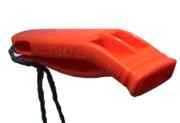 One-piece plastic whistles are small, cheap, unaffected by water, and loud. For example, the Fox 40, Perry (now Plastimo) or Highlander whistles which are often supplied with life jackets and can be bought from a good kayak, marine supply or camping store. See Retail Outlets. This one, marked "3 ITW Nexus - EN ISO 12402-8" is easily the loudest we have tried.
One-piece plastic whistles are small, cheap, unaffected by water, and loud. For example, the Fox 40, Perry (now Plastimo) or Highlander whistles which are often supplied with life jackets and can be bought from a good kayak, marine supply or camping store. See Retail Outlets. This one, marked "3 ITW Nexus - EN ISO 12402-8" is easily the loudest we have tried.
You can attach your whistle to your PFD with a thin cord, but keep it inside a pocket or it may get wrapped round your paddle so you can't roll.

 By sealing the gap between kayak and kayaker, a sprayskirt makes a kayak very seaworthy. It must stay in place even if hit by a big wave.
By sealing the gap between kayak and kayaker, a sprayskirt makes a kayak very seaworthy. It must stay in place even if hit by a big wave. 


 They have something at the waist (a draw-cord, a belt or an elasticated hem) to keep water from flooding up into the jacket in waves or in a capsize. Some have a double waist so that one part of it goes inside your sprayskirt and the other part goes over the top.
They have something at the waist (a draw-cord, a belt or an elasticated hem) to keep water from flooding up into the jacket in waves or in a capsize. Some have a double waist so that one part of it goes inside your sprayskirt and the other part goes over the top.
 When it comes to waterproof kayaking jackets, Greenlandic kayakers have always favored the tuiliq or tuilik. This is a long garment with a hood which fits closely around the face (but is drawn back at the sides so as not to impair vision), cuffs which can be tied closely around the wrist, and a waist which fits closely round the cockpit coaming so there is no need for a separate sprayskirt.
When it comes to waterproof kayaking jackets, Greenlandic kayakers have always favored the tuiliq or tuilik. This is a long garment with a hood which fits closely around the face (but is drawn back at the sides so as not to impair vision), cuffs which can be tied closely around the wrist, and a waist which fits closely round the cockpit coaming so there is no need for a separate sprayskirt.  Sea kayakers usually prefer a PFD designed for kayaking.
Sea kayakers usually prefer a PFD designed for kayaking.  Lifejackets are less effective than PFDs as body armor and thermal insulation, but they are better in rough water because they make you float higher. They may be better all round if you kayak mainly in hot weather or there is a risk you may spend a long time floating in the sea awaiting rescue.
Lifejackets are less effective than PFDs as body armor and thermal insulation, but they are better in rough water because they make you float higher. They may be better all round if you kayak mainly in hot weather or there is a risk you may spend a long time floating in the sea awaiting rescue.  The other style of lifejacket is the Mae West type which has about 50 newtons of permanent foam buoyancy, mainly on the chest. This one is built to last, using military specification neoprene-coated nylon. It looks bulky because it's inflated to 150 newtons. It has a whistle on the left, an oral inflation tube on the right, and the short orange strap in the middle is a lifting becket which can be used to lift a casualty out of the water. The light-colored patches are reflective tape.
The other style of lifejacket is the Mae West type which has about 50 newtons of permanent foam buoyancy, mainly on the chest. This one is built to last, using military specification neoprene-coated nylon. It looks bulky because it's inflated to 150 newtons. It has a whistle on the left, an oral inflation tube on the right, and the short orange strap in the middle is a lifting becket which can be used to lift a casualty out of the water. The light-colored patches are reflective tape.  One-piece plastic whistles are small, cheap, unaffected by water, and loud. For example, the Fox 40, Perry (now Plastimo) or Highlander whistles which are often supplied with life jackets and can be bought from a good kayak, marine supply or camping store. See
One-piece plastic whistles are small, cheap, unaffected by water, and loud. For example, the Fox 40, Perry (now Plastimo) or Highlander whistles which are often supplied with life jackets and can be bought from a good kayak, marine supply or camping store. See